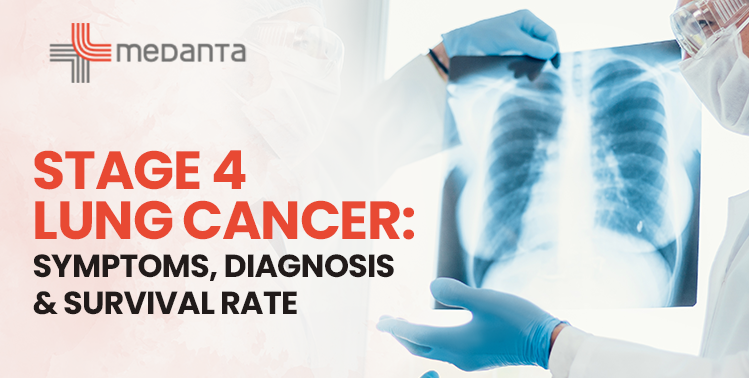CH Baktawar Singh Rd, Medicity, Islampur Colony, Sector 38, Gurugram, Haryana 122001

21 May, 2025
adminLung cancer is one of the most common types of cancer around the world. It can be a serious illness, especially when it is found in the later stages. One of the most advanced forms is Stage 4 lung cancer, which means the cancer has spread from the lungs to other parts of the body. Although this stage is very serious, there are treatments and support options available to help people manage it and live longer, more comfortable lives.
In this Dr Harsh Vardhan Puri blog, we will look at the symptoms of Stage 4 lung cancer, how it is diagnosed, and what the survival rates are. This information can help patients and their families understand what to expect and how to move forward after diagnosis.
Lung cancer starts in the lungs, but at Stage 4, it has moved to other parts of the body like the brain, bones, liver, or adrenal glands. This process is called “metastasis.” Because the cancer is no longer limited to the lungs, it is much harder to treat.
There are two main types of lung cancer:
Both types can reach Stage 4, but treatment and survival rates can vary depending on which one a person has.
Also Read: Stage 3 Lung Cancer: Symptoms, Diagnosis & Survival Rate
The signs of lung cancer in its later stages are more serious and widespread than in the early stages. The Stage 4 lung cancer symptoms may vary depending on where the cancer has spread. Common symptoms include:
If the cancer has spread to other parts of the body, you might also experience:
It’s important to remember that not everyone has all of these symptoms. Some may experience only a few, and others may notice symptoms that seem unrelated at first.
A proper Stage 4 lung cancer diagnosis usually requires several types of tests. Doctors need to confirm the presence of cancer, find out how far it has spread, and understand its type. The following methods are often used:
All of this information helps the doctor create a treatment plan that fits the patient’s specific case.
Also read: What Stage Of Lung Cancer Is Curable?
While Stage 4 lung cancer is not considered curable, it can still be treated. The goal of treatment is to slow the cancer’s growth, ease symptoms, and help the person feel better and live longer.
Common treatment options include:
Each patient’s treatment plan is different and depends on things like age, overall health, cancer type, and how far it has spread.
Also Read: Different Stages of Lung Cancer and Their Respective Curability Rates
When discussing Stage 4 lung cancer survival rate, it’s important to remember that statistics are just averages. They do not predict how long any one person will live. Still, these numbers can help people understand the general outlook.
For non-small cell lung cancer (NSCLC):
For small cell lung cancer (SCLC):
These numbers might sound discouraging, but every person is different. Some people live much longer with the help of new treatments, especially when their cancer responds well to therapy. The survival rate is also improving over time as research and treatments advance.
Several things can affect a person’s chances of living longer with Stage 4 lung cancer:
Living with Stage 4 lung cancer can be overwhelming. But many people find strength in support groups, counseling, and talking to others who are going through the same thing. Staying informed and working closely with a healthcare team can help patients make the best decisions for their care.
Patients are encouraged to:
Even if the cancer cannot be cured, there are ways to manage it and live meaningfully.
Stage 4 lung cancer is a tough diagnosis, but it’s not the end of the road. With the right treatment, good support, and up-to-date information, many people are able to manage the disease and maintain their quality of life. Understanding the Stage 4 lung cancer symptoms, how it’s diagnosed, and the available treatment options can make a big difference.
While the Stage 4 lung cancer survival rate is low compared to earlier stages, hope is not lost. Medical research is moving forward, and new therapies are being developed all the time. Everyone’s journey is different, and no one should go through it alone.
Category : Lung cancer Stages
Tags: